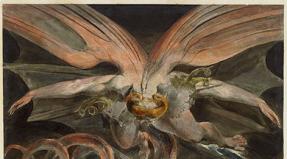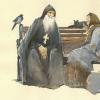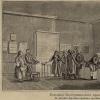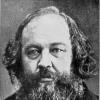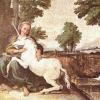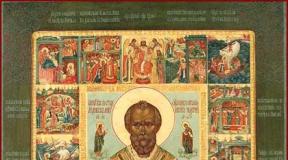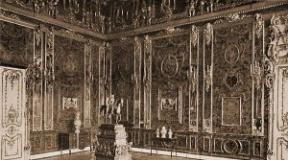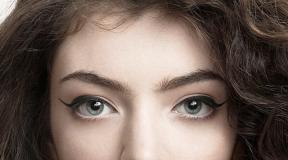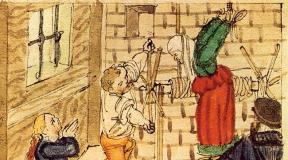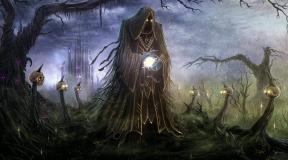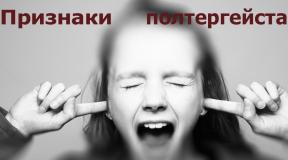Symbolism of geometric figures and ideograms. Symbolism of Regina - book of magic Pendant rhombus in the center of the circle meaning
MOSCOW CITY
PALACE OF CHILDREN'S (YOUTH) CREATIVITY
Art Education Center
Arts and Crafts Studio
CONFERENCE
EDUCATIONAL RESEARCH WORKS
"DECORATIVE AND APPLIED ARTS"
SUBJECT:
“The use of the rhombic pattern of the Arkhangelsk region in modern knitwear”
Teacher: Muranova N.N.
Students: Aleshina Yulia
Bazilian Margarita
Belousova Irina
Moscow, 2008
The rhombic pattern has come to us from the depths of centuries, when many symbols had a certain meaning. With their help, people showed the world around them and their attitude towards it, towards life and death. The rhombic pattern is most often found in the Arkhangelsk region.
The purpose of our work is study of the rhombic ornament of the Arkhangelsk region.
The problem that we will try to solve in our research is the use of elements of traditional folk patterns in modern knitwear to decorate the interior.
To achieve these goals, we have set ourselves the following tasks:
- studying the varieties of rhombic patterns used in the Arkhangelsk region;
Comparative analysis of various diamonds;
Study of current trends in knitwear;
Mastering the technique of jacquard weaving on a flat-knitting double-fold machine;
Development of technical drawings based on the studied material;
Drawing sketches of models.
The simplest ornamental symbols such as: rhombus, square, dots, etc. appeared from the time when a person picked up coal or chalk and began to draw. Even then they began to have a certain meaning, over time it changed, new meanings appeared, in other words, the ornament evolved along with man.
Let's consider one of the simplest symbols that has been known to man for a long time - Rhombus . It is one of the fundamental symbols and is part of the ancient rhombus - meander pattern, which denoted a person’s ideas about the surrounding reality. There are several hypotheses and studies on the origin and meaning of the rhombic pattern.

Let's consider the point of view of paleontologist V. Bibikova in 1965. Based on some found household items dating back to the Paleolithic, a hypothesis was put forward, from which it followed that the rhombus - meander pattern of various bone and wooden products - is a repetition of the natural pattern of dentin of mammoth tusks. And from this she concluded that the diamond-meander ornament for the people of that era was a symbol of the mammoth. It could mean wealth, strength and power, or bring good luck in hunting.
Rhombus is the ancestor of many symbols characteristic of geometric patterns. The rhombic-meander pattern was widely used in decorating pottery; for example, for ritual vessels and plastics, it was almost obligatory, coexisting with other ritual symbols.

 There was also a type of diamond-meander pattern with 2 meander stripes located at an angle to each other. Thus, at the intersection of meanders, the sun sign is obtained, better known as swastika.
It occupied one of the leading places in geometric patterns. This name is very ancient Sanskrit and cannot be translated into other languages. It can be divided into two parts su - good and asti y before a is replaced by v, that's why we get the basis svasti. This sign gives everyone happiness and brings goodness. And if you put 2 swastikas on top of each other at 45 degrees, you get a sun sign polovrat.
There was also a type of diamond-meander pattern with 2 meander stripes located at an angle to each other. Thus, at the intersection of meanders, the sun sign is obtained, better known as swastika.
It occupied one of the leading places in geometric patterns. This name is very ancient Sanskrit and cannot be translated into other languages. It can be divided into two parts su - good and asti y before a is replaced by v, that's why we get the basis svasti. This sign gives everyone happiness and brings goodness. And if you put 2 swastikas on top of each other at 45 degrees, you get a sun sign polovrat.
 The rhombic-meander pattern is the progenitor of many different patterns, but there is an opinion of archaeologist P. P. Efimenko about the primary lattice. According to him, the rhombic pattern was based on a rhombic lattice. It is present in most crafts. For example, in wood (bone) carving it was often used on spinning wheels, this is explained by the fact that traditionally the earth on spinning wheels was depicted as a rectangle shaded with straight and oblique lines, which was located at the bottom of the blade, which generally resembled a plowed field.
The rhombic-meander pattern is the progenitor of many different patterns, but there is an opinion of archaeologist P. P. Efimenko about the primary lattice. According to him, the rhombic pattern was based on a rhombic lattice. It is present in most crafts. For example, in wood (bone) carving it was often used on spinning wheels, this is explained by the fact that traditionally the earth on spinning wheels was depicted as a rectangle shaded with straight and oblique lines, which was located at the bottom of the blade, which generally resembled a plowed field.

Types of lattice rhombuses according to the hypothesis of P.P. Efimenko
I believe that it was not the rhombic lattice that was fundamental, but the rhombic-meander pattern. Because I think his explanation is more convincing and correct. And from them follows an explanation of the meaning and history of many rhombic patterns, which are based on the simplest geometric figure - rhombus with right angles .
There are many different diamonds: a diamond with hooks, divided into several parts, with extended sides, etc.

Examples of variations of geometric symbols
Let's take for example rum divided into 4 parts , also called "Sown field." It is, first of all, associated with wedding rituals and with the life of a young married woman, forcing us to pay special attention to it, since the entire wedding ritual is permeated with magical content, and primarily with the magic of fertility. It is well known that the idea of fertility in wedding rituals appears in two forms: firstly, as the future fertility of the bride, and secondly, as the fertility of plowed and sown land (a loaf of bread, sprinkling with grain, laying straw, etc.) . A woman is likened to the earth, the birth of a child is likened to the birth of a new grain, an ear. This fusion of the agricultural and feminine principles is reflected not only in the external similarity in the similarity of the essence of life phenomena, but also in the desire to merge in the same spells and good wishes the happiness of a new family, the birth of new people and the yield of the fields, which ensures this future happiness. Here we see the very complex that was expressed in ancient Rus' by the concept of “woman in labor”, “makoshi” - the patroness of both fertility and productivity.
Also, many researchers talk about the fourfold nature of this symbol and base their reasoning on this. That is, dividing a rhombus into 4 parts has a special meaning, for example, in folklore there is a lot of evidence of this, in proverbs: “four corners of a house to build, four seasons to complete,” “a hut cannot be cut without four corners,” “ four walls on four sides" etc. The concept of fourfoldness was founded in ancient times and it is based on the simplest concepts that surrounded ancient people: “4 cardinal directions, 4 seasons, etc.”
For example, the 4 cardinal directions explain the meaning of a symbol such as a rhombus divided along the middle of the sides. To do this, consider the process that was carried out before the construction of the estate began. The head of the family had to consecrate a plot of land allocated for the construction of a new home. For this purpose, he drew a large square on the ground, the size of an estate, and divided this square into four parts so that four small squares were formed. Then the owner of the future estate went “to four directions” and brought a large stone from four fields. The stones were placed in the center of each small square drawn on the ground. After which the land of the future estate was considered consecrated. From this we can conclude that a rhombus with divided sides was associated with housing, that is, it had the meaning of a hearth-home, well-being and protection.
Then the owner of the future estate went “to four directions” and brought a large stone from four fields. The stones were placed in the center of each small square drawn on the ground. After which the land of the future estate was considered consecrated. From this we can conclude that a rhombus with divided sides was associated with housing, that is, it had the meaning of a hearth-home, well-being and protection.
The protective meaning of this symbol is also confirmed by another fact. It is known that in the hut the logs in the log house were stacked with the remainder; this remainder looked like a spear, a fork. The Russians even have a riddle: “On the outside there is a horn, on the inside there is a kamola” (izba). With the laying of the first crown, the space was ordered, its isolation and impenetrability to external, evil forces was ensured, chaos was transformed into space (that is, order). It is noteworthy that even when the hut was cut down without a trace, the first crown, on the ground, was always horned. Apparently, the close proximity to the “underworld”, the “house of the dead” required security from such a neighborhood, from the possible evil “intrigues” of the “inhabitants of the underworld”. Moreover, the earth was given the remains of enemies killed in battles during raids, and the ancient Slavs burned their relatives on a funeral pyre. Timber-type burials are also known. From here it is clear why the presented motifs of a rhombus with sides extended at the corners, with a marked middle, called a “rhombus-burdock” (also known as a “small lattice”), symbolized a log house, an enclosed space with a hearth or altar - the habitat of the ancestors.
|
|


Views of different types of diamonds in embroidery on vintage towels
For some tribes, this symbol had the meaning of the sun, a round sun with rays, but due to the fact that this symbol was used in embroidery and weaving, it was distorted into a rhombus with extended sides and rays. This rhombus with extended sides had the meaning of protection, both from real enemies and from dark forces, and it also had the meaning of the sun, that is, fire, heat, goodness and light.
The descendant of a rhombus with extended sides is diamond with hooks , described in detail in the article “Rhombus with Hooks” by A. K. Ambrose. This rhombus indicated that the first reason for research was the discovery of dishes with engraved images of rhombuses with hooks at ancient settlements of the “Pochen” culture (1st-2nd centuries). These signs were not intended to decorate the dishes, as they were located either on the side or at the bottom of the vessel.

Diamonds with hooks on pottery (1st-2nd century)
The search for ethnographic analogies showed that the studied sign is one of the main elements of peasant geometric patterns of the 18th-20th centuries. It has many options.

 Let's look at the most common of them. For example, sign indicating
heavenly fire - the fire of the heavenly forge, the forge of Svarog, Thor
- one of the main creative forces. Let's draw some analogies with the Sun and plasma and the big bang theory and the period of the formation of the Earth, when active tectonic processes and volcanic eruptions took place on it.
Let's look at the most common of them. For example, sign indicating
heavenly fire - the fire of the heavenly forge, the forge of Svarog, Thor
- one of the main creative forces. Let's draw some analogies with the Sun and plasma and the big bang theory and the period of the formation of the Earth, when active tectonic processes and volcanic eruptions took place on it.

 The interpretation of this sign is also widely known as union or confrontation of two principles
. The theme of unity and conflict of two diametrically opposed forces is one of the main, if not the main law in paganism, the law of the existence of the world. This is the dual couple Prav-Nav, this is Day and Night, this is, finally, a man and a woman. Rule is the kingdom of all-conquering truth, justice, the kingdom of the bright gods, it contains the beautiful Irian garden with rejuvenating apples and a milk river, magical birds live in it, people who lived in the Java world according to Rule - fairly, according to conscience (similar to the garden of the Hesperides) go there Greek myths). Nav is a dark kingdom of chaos and destruction, where dark gods and people live according to the laws of Krivda. The conflict between them is clear - Nav is trying to destroy the world, Prav is trying to preserve it, maintains its order in it, but their unity is that none of these forces can win or lose, the world is unthinkable without them, their existence is a condition the existence of the world, their unity, we observe in the world of Revealing, the world of people.
The interpretation of this sign is also widely known as union or confrontation of two principles
. The theme of unity and conflict of two diametrically opposed forces is one of the main, if not the main law in paganism, the law of the existence of the world. This is the dual couple Prav-Nav, this is Day and Night, this is, finally, a man and a woman. Rule is the kingdom of all-conquering truth, justice, the kingdom of the bright gods, it contains the beautiful Irian garden with rejuvenating apples and a milk river, magical birds live in it, people who lived in the Java world according to Rule - fairly, according to conscience (similar to the garden of the Hesperides) go there Greek myths). Nav is a dark kingdom of chaos and destruction, where dark gods and people live according to the laws of Krivda. The conflict between them is clear - Nav is trying to destroy the world, Prav is trying to preserve it, maintains its order in it, but their unity is that none of these forces can win or lose, the world is unthinkable without them, their existence is a condition the existence of the world, their unity, we observe in the world of Revealing, the world of people.
 Another version of this sign meansbird,
this is the sign through whichthe animal world is reflected in symbols. The signs inherited the properties of animals. Signs denoting birds have a special meaning, for a bird is a creature for the ancients
Another version of this sign meansbird,
this is the sign through whichthe animal world is reflected in symbols. The signs inherited the properties of animals. Signs denoting birds have a special meaning, for a bird is a creature for the ancients mysterious, magical. Many light gods can turn into a bird. Perun - into an eagle or a raven, Volkh - into Finist - the Falcon. And in embroidery this sign often denoted a person’s soul.The number of feathers on it should also correspond to sacred numbers. The soul, as a symbol, in applied art is similar to a bird.
mysterious, magical. Many light gods can turn into a bird. Perun - into an eagle or a raven, Volkh - into Finist - the Falcon. And in embroidery this sign often denoted a person’s soul.The number of feathers on it should also correspond to sacred numbers. The soul, as a symbol, in applied art is similar to a bird.
 Diamond with hooks
It is found in many crafts and ornaments not only in explicit form, but it, as a basis, can also be seen in various symbols. Let's take, for example, a little-known symbol fern flower Firebloom
. According to a legend that has come down to us since the times of pagan beliefs, a fern flower bloomed on the night of Ivan Kupala, when, according to pagan beliefs, it began to get cold, then young people and girls went into the forest and looked for the Fireflower, which bloomed for only one night, the one who found it received love and happiness.
Diamond with hooks
It is found in many crafts and ornaments not only in explicit form, but it, as a basis, can also be seen in various symbols. Let's take, for example, a little-known symbol fern flower Firebloom
. According to a legend that has come down to us since the times of pagan beliefs, a fern flower bloomed on the night of Ivan Kupala, when, according to pagan beliefs, it began to get cold, then young people and girls went into the forest and looked for the Fireflower, which bloomed for only one night, the one who found it received love and happiness.
 If we look closely at the Fireflower sign, we will see that it is one of the symbols called a diamond with hooks. And, indeed, at the heart of this symbol there is a rhombus in the center, its sides are extended upward and curved towards the ground. Also, if we look closely, we can see in this symbol the signs already known to us: a bird sitting on the top of a flower, two lines bent in half, shifted in such a way that a rhombus is obtained in the middle, which together represents a sign of two principles, and also, looking closely, we can see a modified symbol of heavenly fire, which was often interpreted as the sun. Thus, the sign of the Fireflower or fern flower combines several simple symbols with a meaning already known to us, so we see that the Fireflower includes the human soul, the sun and two opposing principlesRule and Nav or Good and Evil. That is, Fireflower included a certain model of the world, characteristic of a pagan, in which were located: the sun, as the heart of the world, and a person between Rule and Nav. This symbol simply described the ancient man’s idea of the real world around him.
If we look closely at the Fireflower sign, we will see that it is one of the symbols called a diamond with hooks. And, indeed, at the heart of this symbol there is a rhombus in the center, its sides are extended upward and curved towards the ground. Also, if we look closely, we can see in this symbol the signs already known to us: a bird sitting on the top of a flower, two lines bent in half, shifted in such a way that a rhombus is obtained in the middle, which together represents a sign of two principles, and also, looking closely, we can see a modified symbol of heavenly fire, which was often interpreted as the sun. Thus, the sign of the Fireflower or fern flower combines several simple symbols with a meaning already known to us, so we see that the Fireflower includes the human soul, the sun and two opposing principlesRule and Nav or Good and Evil. That is, Fireflower included a certain model of the world, characteristic of a pagan, in which were located: the sun, as the heart of the world, and a person between Rule and Nav. This symbol simply described the ancient man’s idea of the real world around him.
There were also many others types of rhombuses :
 - rhombuses with extended and hooked sides
- a field that has sprouted;
- rhombuses with extended and hooked sides
- a field that has sprouted;
- ordinary rhombus , stood for Mother Earth;
 -
rhombus crossed by two diagonals
, had a popular name - “khryast” - a plowed field;
-
rhombus crossed by two diagonals
, had a popular name - “khryast” - a plowed field;
 - rhombus with points at the corners
(also a favorite folk motif), was called “burdock” and, in turn, was divided into many motifs: a rhombus with marks on the sides - “comb”, with towns, etc.
- rhombus with points at the corners
(also a favorite folk motif), was called “burdock” and, in turn, was divided into many motifs: a rhombus with marks on the sides - “comb”, with towns, etc.
 Along with the complications of the rhombus, we should also mention its simplifications:
Along with the complications of the rhombus, we should also mention its simplifications:
- triangle (his half);
- zigzag (repetition of triangles).
TO rhombic patterns also applies oblique cross , always placed between diamonds. This cross has a number of complications in the form of enriched ends. This also includes patterns in the form of the letter S and a peculiar female figure, where diamonds represent the head and body, hooks represent the arms, and a triangle represents the skirt. Popularly this pattern is called “buffoons”.
Based on the material studied, the following conclusions can be drawn: the sign being studied retains its general shape, but varies endlessly in details. Hooks are interpreted either in the form of smooth curls, or spirals, or meanders. The sign sometimes has one, sometimes two, sometimes four pairs of hooks. In pairs, the hooks are bent either outward or inward. The rhombus also varies: its middle is either empty or crossed by two or more perpendiculars (checkers, sometimes with dots in the center of each checker); consists of two triangles or is shaded at an angle, etc. The variability of the details of the form, however, does not change the essence of the sign.
It is impossible to draw a sharp line between a diamond with hooks and other variants of diamonds. As was written earlier, the shapes differ in a simple rhombus (“circle”), a “burdock”, a “circle” with many “offsets”, a rhombus with two pairs of marks, a rhombus with four marks located

in the middle of the sides - the possibility of variation is great. But there is no doubt that all rhombuses, including rhombuses with hooks, form one large group of related symbols.
The materials studied do not yet make it possible to accurately date the time of the appearance of the rhombus, the rhombus with hooks, since almost all of its images date back to the time when a purely cult symbol began to turn into an ornament. The most likely time for the emergence of the rhombus remains the period of the early productive economy, “the period of the spontaneously demonic chthonic worldview” in the terminology of A.F. Losev. “At this time, man first began to control the operation of certain laws of nature; the concept of a thing arose."
The symbol was an image of a deity, and therefore was depicted during ritual actions. Diamonds with hooks could be drawn on the ground and on bread, so their early, unornamental images have hardly survived. Some idea of such rituals is given by the previously described custom of “mortgaging an estate.” Another group of possible rituals are rituals of the all-grass type. Cereal grains were boiled in a special vessel, magically imitating the singing of crops and grains.
Gradually, the symbol of fertility underwent some changes and was divided into several varieties.
The cult of good snakes, guardians of water, led to the appearance of a pattern of two coiled snakes, which is a modification of the meander. A “snake meander” appeared, reminiscent of a wave and a classic meander, expressing the idea of water.
The second direction was to connect the diamond with the point. Even in ancient times, a pattern of four rhombuses with a dot inside each of them appeared and became established in folk ornaments for centuries. This kind of rhombus has been found for many centuries right up to the present day. It was especially often used to decorate wedding items (towels, blankets, etc.), which confirms the close connection of ideas about the fertility of the earth with the fertility of women, which has long been known from folklore data.
The third direction is to transform the rhombus into a stable symbol of fertility. Curls or sprouts were added to the rhombic base at the outer corners of the diamond.
Gradually, the sign lost its significance as a shrine, but retained its magical meaning. For example, in the mid-19th century, the ritual of “reading” patterns during the Epiphany viewing of brides was preserved. The old woman showed the assembled guests the hems of the bride's shirts embroidered and explained the meaning of each pattern.
Finally, the sign turns into only decoration. The laws of artistic creativity come into full force, the shape of the sign quickly becomes distorted and disappears, and a large number of varieties of rhombus appear.
In the clothing of the Slavs, two colors were widespread - white and red, but they were presented in all their shades, since these were the colors of the Sun: white is “white light”, the clear light of the Sun; red is warmth, heat, fire given by the Sun.
Blue, light blue and green colors were allowed in clothing, like the colors of water and forest, but the predominance of white and red undoubtedly always existed.

 |
So, we have looked at many symbols characteristic of the north of Russia, based on the rhombus. Each of them is very interesting
its history and interpretation. Therefore, we decided to use them in our work. Our work includes not only a rhombic pattern, it also belongs to the Russian style, which is now widespread in design. It includes well-known elements of Russian culture from beadwork motifs to architectural complexes and structures that have come down to us, from Khokhloma, Gzhel to Vologda lace, all this is studied and transformed into design ideas. Nowadays fashion prevails following trends :
Products with imitation hand knitting, which are complemented by ethnic attributes, are fashionable;
Basic requirements in fashion: layering, plasticity, large designs and abstraction;
Main trends: geometric patterns of the past, viewed through the prism of the future;
The use of bright contrasting colors in knitwear, such as red, white, blue, yellow, green
It is also now fashionable to decorate knitwear with various accessories, for example, lace and embroidery, pom-poms, velvet pom-poms, decorated with rhinestones or beads.
In accordance with fashion trends and having studied the rhombic pattern of the North, we reworked it into our set.
Our set is based on a diamond pattern. We had several options for the blanket. They are varied; when developing the sketches, we wanted to display a certain meaning in the arrangement of the ornament. First, we developed sketches based on the simplest elements of a rhombic pattern, for example, a rhombus divided into four parts. But later we decided to use a more simplified layout: just stripes of jacquard or squares located along the contour, or a space completely filled with squares.


 IN
IN 

As a result, we chose the last option, in our opinion, with its help it is easier to express the fullness and versatility of the rhombic pattern of the north. Our blanket, as you can see, is divided into squares. We chose this particular geometric shape because in semantics it is directly related to the rhombus and often has the same meaning. Inside each square there is a rhombic pattern compiled by us based on the rhombic pattern. We have compiled many technical drawings and sketches, varying in appearance and composition.
We divided the square into horizontal and vertical stripes, made a continuous pattern and vice versa, the pattern was inconsistent in places, etc. From the compiled drawings, we chose the most suitable and, in our opinion, correct sketches.
Figure No. 1

Each square in our country, just like each symbol in ancient times, had a certain meaning, for example, the basis of the first square is the widely known and used in various crafts sign of a sown field. In this square, we wanted to demonstrate how we can show the traditional Russian peasant motif of land, harvesting and sowing crops, and also well-being and wealth. For the people of ancient Rus', an object with such an image helped during agricultural work and brought wealth and good luck to the house.
Figure No. 2

And the second square denotes the light kingdom. We would now call it “paradise”, but for a pagan this is the kingdom of Rule. In the center of our composition there is a symbol similar to the symbol of Heavenly Fire, to the right and to the left of it there is a direct and mirror image of a bird or the human soul, and there we also see an abundance of small rhombuses, which in turn means abundance and goodness. We see on this square: the souls of people, various beautiful birds, an abundance of various blessings around, and in the center of all this is heavenly fire.
Figure No. 3

In the center of the third square there is a sign of two principles, in this case, we consider it as a designation of a man and a woman; to the left and right there are large rhombuses, which in this context denote home and hearth. In this sketch we allowed ourselves to add our own element, this is a kind of heart, known to everyone as a symbol of love. As a result, this square depicts a man and a woman with love in the air next to them, and they, in turn, are near the house in which the family hearth is burning.
Figure No. 4

The fourth square also depicts a symbol of the confrontation between two principles, in addition, a sown field is depicted here, and then we see a rhombus with extended sides, it carries the meaning of protection and denotes the luminary of the day - the sun. If we assume that the two elements are the seasons - summer and autumn, then it turns out that the time of harvest is depicted here, or rather the end of summer - the beginning of autumn, when the sun does not heat so much, leaves the pedestal of its greatest activity, so it is depicted from the edge of the composition. At this time, the harvest is already ripe, but not yet harvested, so there are still points on the field.
 We not only tried to create a traditional pattern for a rhombic ornament, but were also able to put into it a meaning characteristic of a resident of ancient Rus'. We knitted all this not with our hands, which would have been more traditional, but with the use of modern hand knitting machines. We also used a new method for knitting using a punched card. We studied this method during the classes, we studied the method and its application in practice in more detail, we understood the simplicity and usefulness of punched cards.
We not only tried to create a traditional pattern for a rhombic ornament, but were also able to put into it a meaning characteristic of a resident of ancient Rus'. We knitted all this not with our hands, which would have been more traditional, but with the use of modern hand knitting machines. We also used a new method for knitting using a punched card. We studied this method during the classes, we studied the method and its application in practice in more detail, we understood the simplicity and usefulness of punched cards.
The method itself consists in using a puncher to fill a punched card according to a technical drawing (a punched card is a sheet lined into cells on which rows and cells are indicated, the width of the punched card is 24 needles, so the repeat of our drawings is 24 needles). Where there was a main pattern or background, we did not punch a “hole”, but where there was an additional color, we did).
When creating our work, we used a “single jacquard” weave - this is a weave in which the loops are not formed in a row; in places where loops are skipped, the thread stretches in the form of a broach. From the point of view of production technology, jacquard is a weave in which, when knitting, some needles are switched off from work, so they do not receive a new thread, and old loops are not discarded. It is called single because we knitted on one fabric of the machine.

 As a result, we not only created a wonderful set, but also mastered new knitting methods, we also discovered a previously unknown Russian style in interior design and, most importantly, became acquainted with the symbolism of the rhombic pattern of the north. We were able to bring together all this new knowledge and apply it to our work.
As a result, we not only created a wonderful set, but also mastered new knitting methods, we also discovered a previously unknown Russian style in interior design and, most importantly, became acquainted with the symbolism of the rhombic pattern of the north. We were able to bring together all this new knowledge and apply it to our work.
Terminology:
Rhombus - one of the fundamental symbols. It is part of the ancient rhombic-meander pattern, which denoted a person’s ideas about the surrounding reality, filled with forces incomprehensible to him. Later, in the Neolithic, the rhombus symbolized the feminine principle: fertility began to be associated with a woman. Further, the rhombus, divided into 4 parts, was a symbol of fertility and a sown field. In the Middle Ages, in Christianity and Islam, a square was a symbol of the earthly world, and a rhombus superimposed on it was a symbol of the heavenly world. The symbol indicated the presence of the heavenly world in the earthly world. And the protection of the heavenly world. In Russian folk culture, the rhombus was also a symbol of protection. The rhombus has a protective meaning among most peoples of Eurasia and symbolizes the presence of higher powers.
Jacquard - This is a weave in which the loops are not formed in a row; in places where loops are skipped, the thread stretches in the form of a broach. From the point of view of production technology, jacquard is a weave in which, when knitting, some needles are switched off from work, so they do not receive a new thread, and old loops are not discarded.
Single jacquard – jacquard, which is knitted on one machine.
Kolovrat – two swastikas superimposed on each other at 45 degrees.
Swastika – the sun sign that is formed at the intersection of the meander. It occupied one of the leading places in geometric patterns. This name is very ancient Sanskrit and cannot be translated into other languages. It can be divided into two parts su - good and asti - there is, to be. According to the rules of grammar in front of a is replaced by b, that's why we get the basis svasti. This sign gives everyone happiness and brings goodness.
Ornament - (ornamentum- decoration) - a pattern consisting of rhythmically ordered elements; intended for decorating various objects (utensils, tools and weapons, textiles, furniture, books, etc.), architectural structures (both externally and internally)interior), works of plastic arts (mainly applied), among primitive peoples also the human body itself (coloring,tattoo). Associated with the surface that it decorates and visually organizes, ornament tends to highlight or accentuatearchitectonicsthe object on which it is applied. The ornament either operates with abstract forms or stylizes real motifs, often schematizing them beyond recognition.
Rombo - dot composition - On wedding “well done” panevas, on the embroidered sleeves of women’s shirts, on girls’ headdresses, the same characteristic pattern is very often found: a rhombus or an obliquely placed square, divided crosswise into four small squares or rhombuses. A small dot must be depicted in the center of each of the four small squares. This composition is called "diamond-dot". Usually this composition is not obscured by other elements. The rhombuses placed on the corner are either single, or run in a stripe in one row, touching only at the corners. Sometimes there is a continuous woven pattern consisting only of such figures, but then gaps are left between the rhombuses, thanks to which the viewer always perceives the main element of this pattern - a figure of four closed rhombuses with dots
Punch card - This is a sheet lined into cells, on which rows and cells are indicated, the width of the punched card is 24 needles, so the repeat of our drawings is 24 needles.
Double-fold flat knitting machine – This is a flat machine - semi-automatic, with two needle beds (or beds).
Makosh - Slavic goddess of universal fate . The name of the Slavic goddess Mokosha is so ancient that establishing its exact etymology is very difficult. For example, B.A. Rybakov regarding the name Makoshi reports:
“Not only the etymology of the name Makoshi is not clear, but even its spelling. Taking the form Mokosh, which is often found in sources, this word was associated with the verb “to get wet” or with the Finnish tribal name “Moksha”, although the Mordovian Moksha itself does not have such a deity. As for the form of writing the name of the goddess, there are two options in both written sources and ethnographic records: Mokosh and Makosh. The compiler of the Piskarevsky chronicler gives both forms at once: “...Makosh or Mokosh.” IN AND. Dahl cites a proverb from which the apologetic pronunciation is clear: “God is not Makesh - let him amuse himself with something.”
Obviously, V. Dahl had in mind a more correct version of the sound of the Russian proverb: God is not Makesha - something for fun. And we can give another similar saying: God is not Mikishka - he sees who has a bump on him. Even in these two works of Russian folk wisdom, we clearly notice an indication of the sphere of activity of the goddess Mokosh - fate, fate, the will of God.
And at the same time, all scientists agreed that Makosh – the only female deity of the ancient Russian pantheon».
Literature:
1) Yuri Arbat “Russian folk painting on wood”, publishing house “Fine Arts”, Moscow, 1970;
2) Collection of articles ed. AND I. Boguslovskaya and V.A. Suslov “Russian folk art of the North”, publishing house “Soviet Artist”, Leningrad, 1968;
3) A.P. Kosmenko “Folk fine art of the Vepsians”, publishing house “Nauka”, Leningrad, 1984;
4) S.V. Ivanov “Ornament of the peoples of Siberia as a historical source. Peoples of the North and Far East”, publishing house of the USSR Academy of Sciences, Moscow, 1963;
5) V.A. Faleeva “Russian folk embroidery”, Leningrad, 1949;
6) Article by A.K. Ambrose "Early agricultural cult symbol. ("Rhombus with hooks")", publishing house "Soviet Archeology", 1965, No. 3;
7) S.V. Zharnikov “On an attempt to interpret the meaning of some images of Russian folk embroidery of an archaic type (regarding the article by G.P. Durasov);
8) Ambrose A.K. On the symbolism of Russian peasant embroidery of the archaic type.- Sov. archeology, 1966, No. 1, p. 61-76;
9) I.I. Shangina “Images of Russian embroidery on ritual towels of the 19th-20th centuries, on the question of the semantics of ancient motifs of plot embroidery”, dissertation, Moscow, 1975;
10) A.A. Belosheyeva “Cosmological representations of pagan Rus' in folk arts and crafts”, abstract, Moscow, 2006;
11) A.A. Tyunyaev “A sown field is the oldest Slavic religious symbol of fertility,” article from the Internet;
12) Roman Bagdasarov “What does a rhombus mean?”, article from the Internet;
13) L.M. Rusakova “The image of the world in the geometric ornament of Russian peasant women”, Novosibirsk, 1987$
14) Vasilenko V.M. "Russian applied art. Origins and formation", publishing house "Iskusstvo", Moscow, 1977;
15) Wagner G.K. “From Symbol to Reality”, Moscow, “Iskusstvo”, 1980;
16) B.A. Rybakov “The origin and semantics of the rhombic ornament”;
BookThe book is a symbol of knowledge, the highest law, religious revelation.
In each of the cultural traditions there was a book that formed its spiritual basis: in Taoism - "Tao Te Ching", in Confucianism - "Lunyu", in Hinduism - Mahabharata, in pagan Greece - "Iliad", in Rome - "Aeneid", in in Judaism - the Torah and Talmud, in Christianity - the Bible, in Islam - the Koran, in the states of the communist bloc - "Capital", in National Socialism - "Mein Kampf", in China during the Cultural Revolution - "Mao's Red Quotation Book". The book symbolized learning and literary activity. Prophets, sibyls, evangelists, and Church fathers were traditionally depicted with a book in their hands. The Annunciation finds the Virgin Mary reading a book. The penitent Mary Magdalene also reads the book. Characters who became famous for their writing were depicted with the book, including the Apostle Paul, Thomas Aquinas, Bernard of Clairvaux, Dominic and others. God the Father and Christ were also often represented with a book on which the letters “alpha” and “omega” were written. A book pierced with a sword is an attribute of Saint Boniface, with a cross lying on it, the personified faith; with the sign of the fleur-de-lis - St. Zenobius. The book with seals refers to the Apocalypse. At the same time, the scribes are interpreted in the Gospel as enemies of Christ. Some mystical books require a special key to understand them: for example, the Sibylline Books or the I Ching. The mythology about the search for the book of truth is also characteristic of many cultural traditions. Hermeticism reported 36 thousand books written by Hermes Trisamegistus, but lost in fires in the Library of Alexandria. Muslims believe that, in addition to the earthly Koran, there is also a heavenly one.
Sacred books are receptacles of the Word, the divine message. It is the Name of God, truth, and mercy that holds a closed book in its hands. The Book of Life of the Apocalypse is located in the center of heaven, where it is identified with the Tree of Life.
Symbol of the universe, the book of peace and the book of life. The open book means the book of life, the teaching and spirit of wisdom, the revelation and wisdom of the scriptures. The book is associated with the symbolism of the tree, and the tree and the book can represent the entire cosmos. In the Grail symbol system, a book can also mean a journey, a search in this case for a lost world.
Paracelsus preferred “reading the book of nature” to theoretical studies.
The book accompanies a person in the afterlife, and peoples who attributed great importance to death left behind the Book of the Dead. Such a book among the Egyptians consists of a set of advice tablets intended for the deceased to help them in their posthumous existence. A similar book among the Mayan Indians, which testified to the transmigration of souls, contained a complete description of the ritual that accompanies the deceased from the moment of his death agony until reincarnation in the womb of a conceived woman, including all the metamorphoses of the soul.
Heart
The symbol of the heart is an absolute cosmopolitan, having no homeland in any particular country, culture or religion. Despite the amazing simplicity of its outlines, this symbol has always been and to this day remains one of the most powerful positive emblems of the world.
The heart symbol is based on a square (placed on a corner so as to form a rhombus, on the two upper edges of which halves of a circle are placed, or, alternatively, the two upper lines are continued, intersected by a cross and bent to the corners of the square, hugging it). From time immemorial, this figure was an ancient sign of earth and fertility, associated with the birth of new life. The two semicircles at the top are symbols of light, or it can be interpreted as a sign of "acceptance under divine protection." Perhaps the people of the past tried to express the formula of life in this symbol: the sacred meaning of the cross should be understood as “I am”, next to it is a house, a woman, land and the protection of the family by higher powers. By the way, during archaeological work in France, exactly such an image was found, where the geometric foundations of the figure’s construction were visible - that is, the modern appearance of the “heart” may be a simplified version with a partial loss of the deep meaning of the guarantees of protection: a man presenting a heart symbol to a woman, thereby hinted at the mercy of heaven, and promised personal care for the safety of the offspring and joint home. It must be admitted that this is a more thorough understanding of love than is accepted in modern times... however, it is also not without its advantages.
Whether this is true or not, nevertheless, there are other versions of the origin of the heart symbol. One of the most common points of view believes that nature itself suggested the symbol to people: visually, the heart is formed by a pair of swans, whose heads and bases of the neck seem to form a pointed bottom. It is not difficult to understand the traditional scarlet color of the figure if the birds are swimming towards each other against the background of the sunset, turning this pattern into a symbol of love. Why swans became the “heroes of the novel” is also no secret. They themselves are a symbol of loyalty and devotion, as well as dedication to the secret plan of higher powers. From ornithology (the science of birds) it is known that a formed pair of swans remains together all their lives, demonstrating the standard of devotion and fidelity - and in the animal world this is especially rarely observed.
Galdino Pranzarone, an American psychologist from Roanoke College (Virginia), believes that the “heart” comes from the ancient symbol of the feminine principle - the Hellenes associated female beauty primarily with the shape of the female pelvic area (viewed from the back). The ancient Greeks worshiped the reproductive function of the feminine principle in the person of the goddess Demeter, but especially Aphrodite Callipygos, in whose honor a temple was erected. As the professor explained in an interview with Discovery News after researching and analyzing literary and mythological sources, the Greeks especially appreciated its rounded shapes, which, apparently, became the prototype of the heart symbol and a logical part of the cult of the beautiful human body. However, it was not originally pointed downward, and it certainly was not red. Galdino Pranzarone suggests that the symbol took on its modern form later, when the Catholic Church adopted it from the Greeks. At the same time, presumably, the symbol was called “heart”, since it was somehow linked to an anatomical organ.

One way or another, this symbol came to people, and its history was created in accordance with the new understanding. Mystics perceived the heart as the seat of the spirit. Alchemists considered the heart to be the personification of the sun inside a person, like gold, which personified the image of the sun on earth. Philosophers of later times saw in the heart the engine of the progress of thought, the source of passion and the focus of life. Astrologers view heart pulsation as a reflection of cosmic vibrations, complementary processes of expansion and contraction, evolution and degradation.
For the ancient Egyptians, the heart was the seat of the soul, and was the key to the afterlife at the Judgment of the ruler of the underworld, Osiris, which is described in detail in the Book of the Dead, so the heart of the deceased was embalmed and buried in special vessels. One of the versions of the Egyptian concept of the cosmos also says that the god Ptah embodied the creation of the living in his heart, which is the seat of thought (which corresponds to the results of modern research that recognized the heart organ as the “fifth spiritual brain”). In the Bible we easily find a similar statement: “I, the Lord, penetrate the heart” (man’s plans) (Jer. 17), “From the heart come evil thoughts” (Matthew 15).
The spiritual aspect of peacemaking is supported by the interpretation of the heart as an image of the center of the world. In the vertical of the human body, the central position is occupied by the heart, in which all qualities and forces are concentrated. Love symbolism is associated with the heart because this feeling is a fundamental spiritual value that elevates a person and expands his own physical nature. In all likelihood, the scarlet symbol eventually became a women's amulet precisely because of its connection with tender and romantic feelings.
Rhombus
A figure that exists in isolation from the “soil” in angular and rigid self-sufficiency. The stability of a rhombus is in its internal area, and the striking force is in the sharpness and strength of the corners.
The rhombus is a tough and “stubborn” figure, purely autonomous in its existence and ensures its “survivability” with a peculiar adaptability inherent only to it. It lies in the ability to change the sharpness of the angles and cross-section. In other words, a rhombus is capable of extremely sharpening its corners, “stretching” in length or, conversely, turning into some kind of square, “placed” on an angle. In the first case, the tip, like a sting, sharply increases the striking penetration, and in the second, a fort is formed, fortified on all sides. The rhombus sign is a symbol of a “hard idea”, a certain paradigm; it, like the triangle, personifies striking force and power, while the latter quality is presented very aggressively in “rhombuses”. The rhombus is the dictate of a single center of power, so the rhombus perfectly personifies the personalization of power. They are extremely rigid and dogmatic (the rigidity and strength of diamonds is ensured from the inside by a cross!), and there must be very good reasons for changing the configuration of a diamond, and the process of such a modification for a diamond is by no means painless.
Can be considered as a derivative of two triangles connected at the bases.
Graphic image:
- uterus, vulva, sometimes - virginity;
- diamond;
- diamond-shaped pattern on the shell of a turtle, a symbol of the lunar-earth goddess.
Basic values:
- female creative principle, femininity, fertility, fertility, mother, motherhood;
- uterus, vulva, pudenda mulieris - usually with a dot in the center;
- happiness;
- all-consuming maternal love, motherhood, Great Mother, Kali;
- the earthly beginning, the darkness of the mother's womb, the grave;
- sea, primordial waters, abyss of fear;
- female generative force.

Celtic Ornament
Celtic ornaments, as part of art, began to take shape with the beginning of the adoption of Christianity. In ancient manuscripts, monks used them to help the reader in his inner search for spirituality. The most common form of patterns in such manuscripts is a labyrinth. These labyrinths lead a person to the center of concentration of living energies. They symbolize continuity and express the connectedness of all things in the universe.
A characteristic feature of these buildings is their direction; they always lead to the center. This suggests that the Celts put more into the labyrinth than just the construction of a “difficult road”.
The Celts imagined the labyrinth as a path to spiritual enlightenment, overcoming adversity, personal ego, teaching oneself to find the true path - a person reached his inner spiritual essence, became wise and enlightened. At the center of the labyrinth is the spiritual power to which man strives.
Note. In the symbolism of the book there is a clear connection with the Symbolism of the Dark Ones. The hearts on the book and on the dagger are the same. But you need to take into account an important feature - the heart on the book is in a rhombus, and this is an exclusively female symbol. Unlike the dagger, which is a male phallic symbol. Thus, we have two magical objects whose symbolism is clearly divided into male and female .

1 - horizontal; 2 - vertical; 3 - cross; 4 - square; 5 - center (point); 6 - circle, circle; 7,8 - triangle; 9 - rhombus; 10 - hexagram, hexagonal star, "seal of Solomon", "star or shield of David"; 11 - circle with a dot in the center; 12 - trapezoid; 13 - pentagram, pentagonal star; 14 - regular pentagon; 15 - regular hexagon; 16 - octagonal star; 17 - regular octagon; 18 - dynamic square; 19 - circle inscribed in a square; 20 - square inscribed in a circle; 21 - concentric circles; 22 - spiral; 23 - square completed by an arch; 24 - square combined with an arch; 25 - square surrounded by an arch; 26 - sphere, ball; 27 - cube; 28 - tetrahedral pyramid; 29 - octahedral pyramid, tent; 30 - tetrahedron; 31 - cone; 32 - obelisk; 33 - octahedron; 34 - icosahedron; 35 - dodecahedron.
When considering the symbolic meaning of lines, shapes and figures in architecture, we note that they have not only emotional expression, but also a deep symbolic meaning associated with their emotional and aesthetic content. Let's consider the symbolic content of the lines, shapes and figures that are quite often found in architecture and the fine arts, shown in Figure 6. When interpreting them, dictionaries of symbols /11,73/ were used.
Horizontal- an ancient sign of the horizon, the earth’s surface, a symbol of passive, feminine behavior.
Vertical- the simplest powerful symbol of ascension and progress, active, active, the main element of creation and a symbol of male power, male behavior, associated with the linga (phallus). This is a symbol that unites the upper and lower worlds.
Cross- one of the four fundamental symbols, which include the square, center and circle. This is an image of fourfold, meaning the material world-eternity. It is a symbol of the earth with four sides, formed by the four elements. It is also a symbol of the suffering of the crucified Christ. This is the basis of all orientation symbols: spiritual orientation - the East-West axis, temporal orientation - the axis of rotation, North-South, bottom-up. This is a symbol of the world tree, or the tree of life, synthesis and measure, the connection of heaven and earth, space and time.
Square- one of the four fundamental symbols. It is a symbol of the earth in opposition to the sky, and also a symbol of the created universe of space; This is an anti-dynamic figure, symbolizing a stop, a selected moment, the idea of stagnation, freezing. In all astrological traditions, the square represents earth, matter, limitation.
Center (point)- one of the four fundamental symbols. This is a symbol of the beginning, of absolute reality, a place of condensation and coexistence of opposing forces, the most concentrated energy. The world axis passes through the center, connecting heaven, earth and the underworld. It is a symbol of creative power and the end of all things.
Circle- one of the four fundamental symbols. It is a symbol of movement (wheel), sky, infinity, universe, time, protection provided within its boundaries. This is an expanded point (center) with general symbolic properties. It is associated with the cult of fire, heroes, and deity. In Christian mythology, the circle symbolizes eternity.
Triangle- very often used in ornamental friezes in India, Greece, Rome. Its meaning appears to be constant. The triangle, with its apex facing upward, symbolizes mountain, fire and male creative power; the triangle, facing downward, symbolizes a cave, water pouring from heaven and running down from the mountains, a fertile womb and the feminine principle. An equilateral triangle symbolizes divinity, harmony, proportion.
Rhombus- female symbol. It is assigned an erotic meaning. It expresses dualistic philosophy, as well as the entrance to the residence of afterlife forces. In a very elongated form, two isosceles triangles connected at the bases and forming a rhombus signify contacts and exchanges between heaven and earth, between the higher and lower worlds, sometimes also the union of the two sexes.
Hexagram- the so-called “star or shield of David”, “seal of Solomon”, representing the ensemble of elements of the Universe, is formed from two triangles superimposed on each other, and means the unification of the creative and generative principles. In this case, a triangle of fire, truncated by the base of a triangle of water, means air, and, conversely, a triangle of water, truncated by the base of a triangle of fire, corresponds to earth. The hexagram thus represents the synthesis of opposites and the expression of cosmic unity and at the same time its complexity.
Circle with a dot in the center in astrology it symbolizes the sun, in alchemy it symbolizes gold and has the symbolic properties of a circle and a center. Similar to itself, without beginning or end, the perfect circle is a sign of the absolute.
Trapezoid- this is a call to movement. Viewed as a truncated triangle, it gives the impression of independence, irregularity or failure.
Pentagram in the shape of a pentagonal star has multiple symbolism based on the number 5, which expresses the union of unequals and thus symbolizes the microcosm. The five rays of the pentagram form a fruitful unity from the number 3, which signifies the masculine principle, and the number 2, which corresponds to the feminine principle. In antiquity, the pentagram meant a symbol of high science, knowledge that opens the way to secrets. The ancients considered it a symbol of a perfect idea. The pentagram also means happiness, wedding, fulfillment, power, the fact of the synthesis of additional forces.
Pentagon has the same symbolism as the star pentagram, but less pronounced.
Hexagon means, according to Christian symbolism, taken from ancient times, the number of death. The hexagon is associated with the image of the burial of a sinful creature - the prelude of its transformation into a noble creature. Associated with the symbol of the number 6, the hexagon opposes the creation of the Creator in infinite balance, and also expresses the number of testing between good and evil. Among the Mayans, 6 is a fatal number and also denotes the day of death.
Octagon (octagonal star) symbolizes rebirth, resurrection. In accordance with Christian symbolism, the octagon evokes the idea of eternal life, which is achieved by immersing the convert in the baptismal font. The octagon associated with the number 8 expresses the universal number of cosmic balance. The octagon has the integrity of a mediator between the square and the circle, between the earth and the sky, and therefore is related to the intermediate world.
Dynamic square- a square rotated by 45° loses its static nature, acquires dynamics and approaches a rhombus in symbolism.
A circle inscribed in a square- This is a cabalistic symbol. It means a spark of divine fire hidden in matter and enlivening it with the fire of life.
Square inscribed in a circle, evokes the idea of movement, change of order or level. The circle added to the square is spontaneously interpreted by the human psyche as a dynamic image of the dialectic between the sublime heaven and earth.
Concentric circles, having the symbolism of a circle, center, they receive the symbolism of a ring, which is a symbol of union, vow, community; they also express the dialectical master-slave relationship, connecting and at the same time isolating. Concentric circles are often interpreted as symbols of immersion in the waters of death, as well as salvation from them.
Spiral symbolizes origin, expansion, development, cyclical and progressive continuation, creative rotation. The spiral represents the evolution of force and movement emanating from the original center and directed towards infinity. The spiral is associated with the cosmic symbolism of the moon, the symbolism of fertility, the repetition of the rhythms of life, the cyclical nature of evolution, the constancy of being while movement is fleeting.
Square completed with an arch, is the basis of the cube-dome structure, which is often used in the architecture and arts of various nations. This combination materializes the dialectic of the relationship between earth and heaven, imperfection and perfection, man and God.
A square combined with an arch, represents a complicated form that provokes a break in rhythm, line, level and invites a search for movement, change, and a new balance. This form, symbolizing inspiration from the external world or level of higher life, becomes the classic example of a triumphal arch, representing the passage of victorious heroes who seem to enter into another way of life, similar to the way of life of the deity, expressed in his power, wisdom and holiness.
A square surrounded by an arch (a fragment of a circle), reflects a dynamic image, a dialectic between the sublime heaven and earth, perfection and imperfection.
Sphere, ball has the symbolism of a circle and has represented perfection and totality since ancient times. In architecture, the sphere is often reduced to a hemisphere, having the same symbolic meaning. The transition from cubic forms to spherical ones, from a square to a circle symbolizes the transition or return from the created to the uncreated, from earth to heaven and means the completeness of completion, the perfection of the completed cycle.
Cube -“a square of squares” has the same meaning among volumes as a square among flat figures. It symbolizes the material world and the ensemble of four elements. Because of its static nature, the cube is a symbol of stability. In a mystical sense, the cube is a symbol of wisdom, truth and moral perfection. The cube connected to the sphere symbolizes the earthly and heavenly totality, the unity of the finite and the infinite, the created and the uncreated, the bottom and the top.
Pyramid tetrahedral has the symbolism of a square, a triangle and a center. This is an image of upward convergence and ascension. The pyramid is also a symbol of the meeting of two worlds: material and spiritual, earthly and heavenly. In Ancient Egypt, the pyramid was a powerful symbol that personified existence, and also carried the idea of the absolute, divine power of the deceased pharaoh, whose soul freely ascends to the sky and descends from there according to its will.
Octagonal pyramid (tent) has the symbolism of an octagon, a triangle and a center. Representing ascension, the octagonal pyramid is a subtle symbol of the meeting of two worlds: earthly and heavenly. The tent is very common in ancient Russian architecture.
Tetrahedron(triangular pyramid) has the symbolism of a triangle and a center and represents fire in geometric symbolism.
Cone- a geometric body that combines the symbolism of a triangle, a circle and a center. The symbolism of the cone is close to the symbolism of the pyramid, associated with the image of ascension and evolution from the material to the spiritual, the image of the progressive spirituality of the world, a return to unity, as well as the image of femininity.
Obelisk- a geometric body that combines the symbolism of a rectangle, trapezoid, triangle and vertical.
Octahedron- a regular polyhedron, the surface of which is made up of 8 triangles, in geometric symbolism personifies air and combines the symbolism of a triangle, rhombus and vertical.
Icosahedron- a regular polyhedron, the surface of which is made up of 20 equilateral triangles, expresses water in geometric symbolism.
Dodecahedron- a regular polyhedron, the surface of which is formed from 12 pentagons, in geometric symbolism takes on the role of an exponent of the entire Universe. This is not only the image of the Cosmos, it is its number, formula, idea, its essence. It expresses the development of the Universe and is a geometric symbol of rotating value.
Comparing the semantic content of individual simple lines, shapes and figures with their symbolic content, we see that their symbolism is largely based on their emotional and aesthetic content.
K. Jung interpreted "... all the wealth of human symbolism as an expression of stable figures of the unconscious, the so-called archetypes, indecomposable in their final essence" .

02.12.2016 18:02
People have always been interested in talismans and amulets that protect against failure and attract joyful events. A variety of objects are used as talismans: pendants, bracelets, decorative coins, figurines and just ordinary things.
It is believed that in order for one of your favorite things to become a talisman, it should be decorated with a symbol that is associated with a certain energy. For example, you can engrave your favorite pen or lighter or apply a specific design - a talisman of a wallet or jewelry.
In this article from the women's online magazine "100 Worlds" we will look at the symbols of geometric shapes - let's see what magical meaning they have.
Geometric shapes symbols
Circle
The circle represents infinity and the cycle of time, which is constantly on the move. After all, a circle is a continuous line on which it is impossible to mark a beginning or an end. It’s not for nothing that the expression “walking in circles” exists.
is constantly on the move. After all, a circle is a continuous line on which it is impossible to mark a beginning or an end. It’s not for nothing that the expression “walking in circles” exists.
In addition, time, in principle, is subject to cyclicity: the seasons, like the times of day, replace each other and repeat their cycle again - in a circle. Thus, the symbol of such a geometric figure as a circle is eternity and cyclicity. Something begins and ends, and this gives rise to the beginning of something new.
Since ancient times, the circle has been considered one of the most powerful protective symbols, averting failures and attracting joyful events. Why? Because it is important to start any action at a certain time, at which the stars are favorable to the person and protect him. In addition, many of our successes and failures are a matter of chance. Namely, the geometric symbol of a circle is associated with time.
And, of course, here it is worth remembering the ancient legends dedicated to dark forces. How did characters in scary fairy tales hide from the eyes of witches and others, how did Khoma Brut from Gogol’s “Viy” defend himself? That's right - outlining yourself in a circle.
Thus, the circle symbol will protect you from negative influences and tell you when and how to act.
A circle in combination with other shapes can have additional meaning - you can read about the magic of other geometric shapes below. Also, a different meaning appears in the circle symbol when it is divided in two - then opposition appears in the symbol: night and day, good and evil, yin and yang.
Triangle
The symbolism of such a geometric figure as a triangle , very difficult. The meaning of this symbol can be interpreted in different ways, but in any case, the triangle is associated with the power of three forces:
, very difficult. The meaning of this symbol can be interpreted in different ways, but in any case, the triangle is associated with the power of three forces:
Birth, life and death
Life, death and new life
Father, mother and child
Body, mind and soul
Past, present and future
Creation, preservation and destruction
It is worth noting that the theory of unity in the Trinity is reflected in many religions.
It is important to note that the equilateral triangle is considered to be the talisman symbol, so that the three sides-forces are in equality and balance.
In addition, let's remember the triangular Egyptian pyramids and small pyramid talismans, which are believed to be associated with the forces of the Universe and are responsible for harmonizing the energy around.
Thus, the symbol of such a geometric figure as a triangle will become a talisman for people who feel the need for the support of higher powers, seek to understand spiritual values and understand what is truly important in life.
Square

The square occupies an important place in the magic of geometric figures.
This figure has four equal sides, and the distance between opposite sides is correspondingly equal. Thus, the symbol of the geometric figure “Square” is associated with equality, harmony, stability and justice.
It is important to note that the sides of the square are smooth and straight, and therefore this symbol also denotes simplicity, straightforwardness and honesty.
Along with this, the square symbol is associated with the power of the four Elements, which equally govern our world: Earth, Water, Fire and Air, as well as with the four seasons.This association also connects the symbolism of the square with world harmony, equality and nature. The connection with the world and the earth makes the square a symbol of fertility, as well as protected space.
Rhombus

The symbol of the geometric figure "Rhombus" since ancient timesassociated with Mother Earth and the feminine principle.
This symbol is present in the beliefs of different cultures, in which the diamond is equally perceived as a good and powerful symbol that can become a talisman.
This figure has something in common with a square, namely, four equal sides. Like the square, the diamond symbol is commonly associated with fertility.
However, a rhombus is a tougher and more stubborn figure than a square. If a square implies stability and equal degrees of angles, then the angles of a rhombus can change.Thus, a rhombus is a more mobile figure, and its corners are sharp. Therefore, the rhombus symbol in the magic of geometric shapes is also associated with strength, mobility, adaptability, power, rigidity and stubbornness.
Accordingly, taking into account the “character” and symbolism of the rhombus, a talisman with this symbol may be suitable:
People who want to express themselves brightly in something - for example, to realize themselves in, for which they will need the qualities listed above: perseverance, perseverance, adaptability, etc. In addition, this symbol of power will help a person become stronger and gain authority.
For those for whom maternal care is of great importance. Let us remember that the rhombus is a symbol of the feminine principle, and maternal love is the greatest amulet in the world. In addition, this symbol can also be considered as a symbol of femininity, which will help in matters of female happiness and the birth of children.
Has the magic of geometric shapes helped you? What symbol did you choose when looking for a design for a talisman? Let me know what you think about geometric symbols in the comments below!
Anastasia Cherkasova, women's Internet magazine "100 Worlds"

Read also...
- Prayers for money and prosperity are the most powerful, how to read
- Fortune telling "Goldfish" will reveal all the secrets of How to make wishes
- The best ways to take revenge on the person who offended and betrayed you
- Conversations with children about St. Nicholas the Wonderworker, his life and miracles Nicholas the Wonderworker life story briefly


